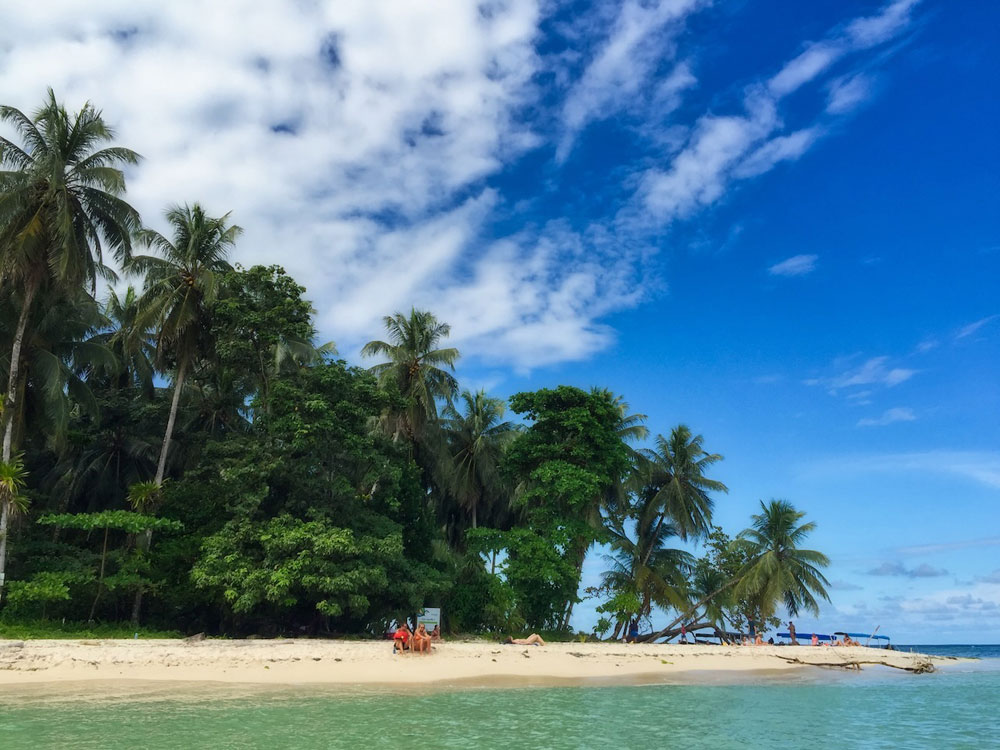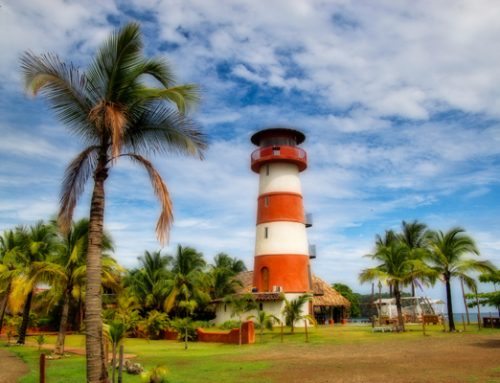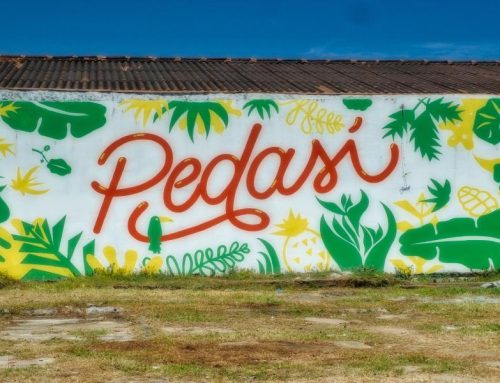What is the best time to visit Panama? Well, the answer to that question depends on exactly where you are going in Panamá and YOU.
Panamá has various microclimates that can result in pretty significantly different weather. And, “best” is a totally subjective word—what’s awesome for one person can be just so-so for another.
The country of Panamá has something special to offer throughout the year. My goal with this guide is to share all of the gifts so you can decide the best time to visit Panama for YOU.
While this post contains some general info on the entire country, it is written from the perspective of visiting us the Vista Cañas Nature & Reading Retreat located on the Azuero Peninsula. If you’re going somewhere different, I encourage you to talk to someone who can give you info on that microclimate.
the two sides of panamá
Although Panamá is a relatively small country, there are two distinct sides to its story—the Caribbean (on the north) and the Pacific (on the south).
The Caribbean side is much wetter and more humid, thus the jungle is lusher and denser. The beaches are more tropical and the sea is that beautiful bright turquoise.
The Pacific side still gets rain, just not as regularly. While it still has a jungle, there are also large patches of farmland in between the clumps of jungle. The beaches are equally beautiful, but in a different way.
Vista Cañas Nature & Reading Retreat is located on the Pacific side on the Azuero Peninsula in what is called the “Dry Arc.”
panama rainy season vs dry season
Panamá has two seasons—rainy and dry. The locals call these “Winter” and “Summer,” but these terms are misleading to those who are not intimately familiar with life in the tropics!
Panamá’s winter has little in common with what most of us call “winter!”
the rainy season in panama (aka “winter”)
The rainy season (AKA “Winter”) usually begins in early to mid-April and typically lasts through about mid-December.
It is NOT cold during these months and, here on the “Dry Arc,” it doesn’t typically rain all the time. In fact, many days usually see quite a bit of sun in between intermittent bursts of rain.
We’ll occasionally get a full-fledged storm with thunder and lightning, but most of the time, the rain just dumps and runs. We do not have hurricanes.
Notice the use of “typically” and “usually” above? That’s because Panamá has a mind of its own—some rainy seasons are shorter and lighter, while others are longer and heavier. You just never know until you’re in it!
For instance, 2021 was a super light rainy season, while 2022 was a very wet “La Niña” year (supposedly the wettest in 50 years). (“La Niña” happens when cooler ocean temps cause more rain; it shifts back and forth irregularly every two to seven years.)
When it comes to vacations, rain scares people off. However, Panamá’s rainy season offers some incredibly special treasures, so you definitely do NOT want to rule it out for a visit!
In fact, it’s my favorite season…because of the lushness of the landscape, the humpback whale migration, sea turtle nesting, amazing insects (including butterflies), and lack of wind.
If you’re one of the following, you should definitely consider coming to Panamá in the rainy season:
- Reader
- Whale watcher
- Sea turtle volunteer or observer
- Bug enthusiast
- In need of “cleansing” & rejuvenation
- Surfer
the dry season in panama (aka “summer”)
The dry season (AKA “Summer”) typically begins in mid-December and lasts about four months until about mid-April.
On the “Dry Arc,” humidity plummets, temperatures rise, the clouds dissipate, the trade winds begin to blow (sometimes really hard), the waterfalls dry up, and everything, but small patches of the jungle and the ocean, turns brown.
While the rain may hamper some of your planned outdoor activities, the wind may do the same in the summer. Ocean-based tours may occasionally be canceled due to dangerous conditions.
Also, most of the smaller to mid-sized waterfalls disappear during the dry season.
If you’re coming to soak up the lushness of the jungle and some tropical waterfalls, you don’t want to come between February and April.
Here are photos that show you the drastic different between the two seasons (these are taken just a couple of months apart!):
10 things to consider when planning your trip to panamá
Panamá doesn’t do much subtly, so let’s look closer at 10 seasonal factors you should consider when planning your trip to Panamá:
#1: Rain—For the most part, rain is not constant during the rainy season. But, if you don’t want a single drop to fall on you, you’ll want to come between the beginning of January and the end of March.
#2: Sun—We rarely have an entire day without sun, but it’s most consistently shining from mid-December to mid-April.
#3: Wind—I really mean WIND. The dry season brings some serious gale force trade winds that challenge me more than the rain. If you don’t want to get blown away, come between May to November. It’s likely that February is going to be the windiest month.
#4: Humidity & Temperature—In the dry season, humidity is lower, but temps are higher; conversely, in the rainy season, humidity is higher, but temps are cooler.
It’s safe to say, you’ll never feel the need to wear long pants here strictly based on the temperature…it’s always warm here.
On the flip side, you’ll use the word “sweltering” much more often in the dry season!
If you want hot and dry, plan to come between mid-December and mid-April; if you want more humid, but cooler, come in one of the other months.
#5: Trees & Vegetation—In the dry season, most of the vegetation on the Azuero Peninsula turns brown and crispy. Many of the trees lose their leaves, in fact.
The good news is that it quickly turns green again once the rain starts, so if you’re coming for the trees, you’ll want to come between mid-May and mid-January.
#6: Waterfalls—A lot of people come to Panamá to see (and swim under!) a waterfall. It might surprise folks that on the Azuero Peninsula, all but the very largest slow to a trickle or disappear in the dry season.
So, if it’s waterfalls you’re after, you’ll want to come between the end of May and the end of January.
#7: Bugs—The bugs be a hatchin’ in the rainy season! But, we have some amazing bugs, including butterflies. Just to throw a wrench in things, you’ll likely see more scorpions in the dry season.
If you’re ready to embrace ALL of nature and want to see some really cool crawling creations of Mother Nature, come between May to December.
#8: Whales—Watching a whale breech from a small panga boat is an awe-inspiring experience that I hope everyone can have at least once in their lifetime.
The whales are generally here from June to December; peak whale season is from August to October.
#9: Sea Turtles—Rescuing sea turtle eggs from poachers and helping babies get safely to the ocean is another cool experience that I hope everyone can do at least once.
We have some sea turtle activity throughout the year, but the peak months are from August to February.
#10: Surfing: You can surf here year round, but the best swells are going to typically be April through June and in December.
best time to visit vista cañas nature & book retreat
As I said, the best time to visit us really depends on YOU and the experience you want to have.
What matters most to you…staying dry or seeing whales, waterfalls or sun?
Here’s a table that summarizes what we generally experience each month at Vista Cañas—I highlighted my personal favorite months in green and my least favorite in pink.
Remember…these are just guidelines as there is absolutely no guarantee that Panamá will follow its own rules! (Click on it to see it full size.)
for vista cañas guests
As I share in my vision for Vista Cañas Nature & Reading Retreat, we are an ideal destination for reading and nature enthusiasts, as well as those seeking rest, rejuvenation and/or healing.
I encourage my guests to come experience all of the gifts of the rainy season that I shared above AND the chance to slow down and do nothing, soak up a book, and listen to the beautiful sound of falling rain.
As many readers tend to be introverts, I’ll also add that there are fewer visitors in the rainy season because so many are solely focused on the sun!
Hopefully, I’ve helped you determine what the best time to visit Panama is for YOU!
Click below to check out our FAQs for more important info that will help you maximize your enjoyment of your trip to the Azuero Peninsula (and Vista Cañas!):













